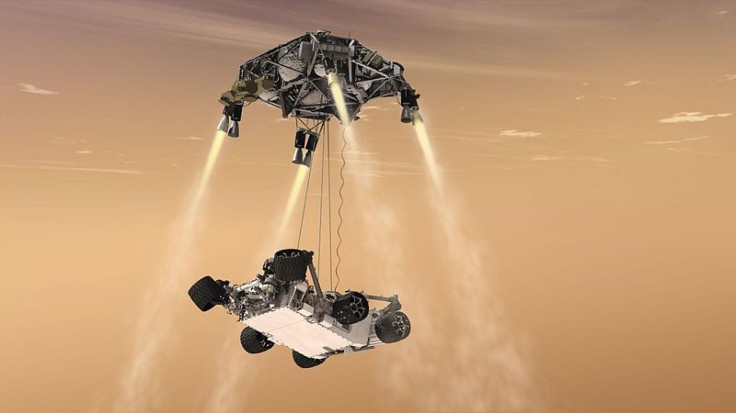Mars Rover Curiosity Landing, As Seen From Times Square

Around 1 a.m. Monday morning, visitors to Times Square would have heard a burst of enthusiastic chanting. Not so unusual for a setting where pop singers and naked cowboys are known to drop by. But this crowd wasn't there to spot a celebrity - the cheer drifting up from Midtown was a rallying cry of "Sci-ENCE! Sci-ENCE!"
The specators had flocked to the heart of the Big Apple to watch the finale of the 36-week, 352 million mile journey undertaken by NASA's latest Mars rover, Curiosity. Just above a much larger video screen dedicated to a Technicolor loop of Dunkin' Donuts advertisements, scenes of blue-shirted NASA researchers and technicians in the control room were intercut with computer animations of the rover's landing stages, which would perform a complex mechanical ballet the space agency had dubbed "Seven Minutes of Terror."
"It's great to see a bunch of people gathered here for this, instead of the usual pop-culture stuff," said Emily McLaughlin, an astronomy teacher at Dreamyard Preparatory School in the Bronx.
Since Curiosity is around five times heavier than previous rovers, NASA couldn't use the usual landing strategy of swaddling it in an airbag and flinging it onto the Red Planet. Instead, Curiosity would be gently lowered to the ground thanks to the "sky crane," a system of cables and wires attached to a hovering rocket-platform.
There was no sound coming from the giant screen (not a technical malfunction, just a necessary measure -- even the city that never sleeps has noise limits), so people coalesced into little knots around their smartphones to hear the NASA broadcast as Curiosity dove into the Martian atmosphere.
Spectator Andrew Cove relayed the play-by-play for his friends: "Parachute deployed... we are decelerating..."
Thanks to a lag between audio and video, the Times Square spectators saw the control room erupt in elation onscreen before the broadcast confirmed that Curiosity had touched down safely inside the Gale Crater on Mars. A new chant rippled through the crowd: "NA-SA! NA-SA!"
For at least two of the watchers, Curiosity's journey had even more personal importance. Mateusz Szczesiak and Andy George work for Manhattan-based Honeybee Robotics, which developed two important tools for Curiosity: a system that lets the rover store and manipulate the samples that it collects, and a motorized brush for dusting off Martian rocks.
Honeybee also supplied tools to the previous rovers Spirit and Opportunity. But according to George, the technology on Curiosity outstrips its predecessors quite handily.
"It's one thousand times more robot," George said proudly.
Another wave of cheering came as Curiosity beamed back its first image from the crater: a gravelly patch of Martian ground.
Now that the rover has landed, it's getting right to work on its two-year mission. The rover has 10 science instruments, some of them completely new to Mars. The rover can fire a laser to check the chemical composition of rocks, and can also drill into the planet's surface to collect samples. Curiosity's primary aim will be to look for clues the Red Planet could once have supported life.
The rover's successful landing also bodes well for any possible future manned missions, which may use a similar descent mechanism.
Back in Times Square, Matt Hopkins, a New York City bartender who wore tin foil molded around a baseball cap, waxed philosophical.
"It's a long road ahead," Hopkins said. "This is just the start."
© Copyright IBTimes 2025. All rights reserved.





















